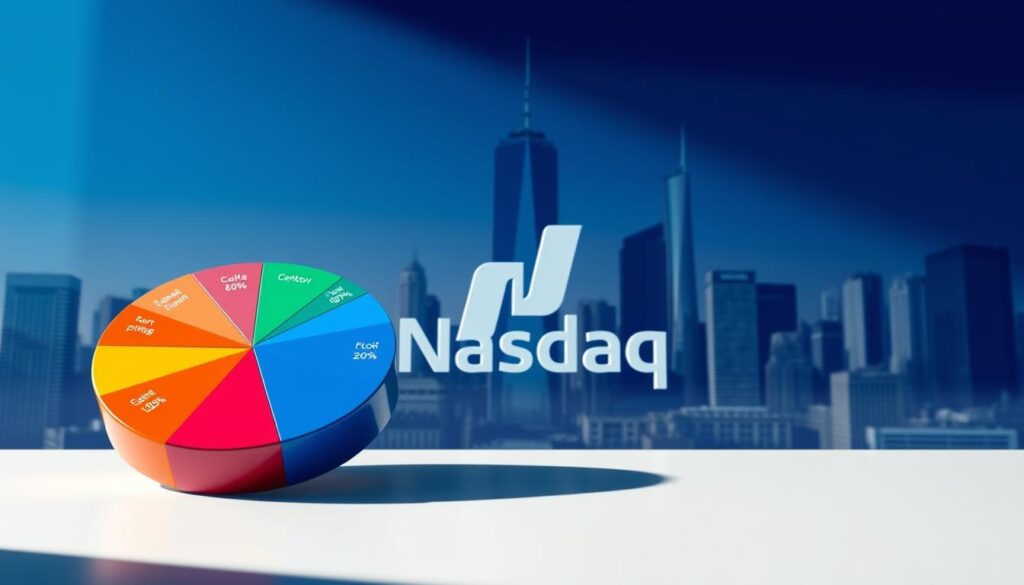The Nasdaq 100 Index tracks the performance of 100 major non-financial companies listed on the Nasdaq exchange. These firms represent fast-growing sectors like technology, healthcare, and consumer goods. Investors use this benchmark to gauge trends in innovation-driven markets.
Unlike other indices, it excludes financial sector companies while using a modified market capitalization method. This approach balances the weight of large corporations, preventing any single company from dominating the index. The result? A clearer picture of diverse industry performance.
By tracking this index, investors gain exposure to globally recognized brands shaping modern economies. It serves as a vital tool for those seeking diversified growth opportunities without direct stock picking. Many funds and ETFs mirror its composition for simplified portfolio management.
This guide explores how the Nasdaq 100 functions as a market indicator and its role in contemporary investment strategies. We’ll break down its unique structure, sector distribution, and practical applications for UK-based investors navigating global markets.
Introduction to the nasqad100 Concept
The Nasdaq 100 serves as a gateway to top-performing tech and growth companies. It simplifies access to 100 leading non-financial firms through a single investment vehicle. This approach removes the complexity of picking individual stocks while capturing sector trends.
Its unique construction uses a modified market cap system. This prevents mega-corporations from overshadowing smaller innovators. Financial institutions stay excluded, focusing the index on sectors driving tomorrow’s economies.
Retail and institutional investors alike favor this structure. Pension funds appreciate its built-in diversification, while active traders leverage its liquidity. The index reflects real-time shifts in consumer tech, biotech, and renewable energy markets.
Three pillars support its effectiveness:
- Transparent selection criteria
- Quarterly rebalancing
- Global brand representation
These features make the Nasdaq 100 index a preferred tool for modern portfolio strategies. Regulatory bodies and data providers collaborate to maintain its accuracy, ensuring reliable performance tracking. Upcoming sections detail how these elements create actionable opportunities for UK investors.
The Evolution of the Nasdaq 100 Index

From its 1985 debut, the Nasdaq 100 index redefined how investors track innovation. Designed to spotlight top non-financial firms on the exchange, it initially focused on emerging tech and growth sectors. The dot-com bubble tested its resilience, while the 2008 crisis highlighted its adaptability during market upheavals.
Three extraordinary rebalancing events shaped its trajectory. In 1998, rapid tech expansion forced its first major adjustment. The 2011 update addressed post-recession market shifts. Most recently, 2023 saw a special rebalance when dominant tech stocks crossed 48% of the index’s weight.
Key evolutionary drivers include:
- Quarterly reviews maintaining sector balance
- Strict caps preventing single-company dominance
- Responsive methodology to global economic changes
This flexibility keeps the 100 index relevant despite fluctuating industries. Tech giants’ rise prompted rule refinements, ensuring smaller innovators still contribute meaningfully. The exchange’s transparency in adjustments helps UK investors trust its long-term stability.
Regulatory updates and digital trading advancements further cemented its role. Today, it serves as both a market barometer and blueprint for growth-focused portfolios worldwide.
nasqad100: Core Features and Benefits
The Nasdaq 100’s design prioritizes balanced growth and risk management. Its modified market capitalization method caps individual company influence, ensuring no single stock dominates performance. This structure spreads weight across all 100 firms, creating stability even during sector-specific volatility.
Quarterly reviews enforce strict distribution rules. Nasdaq analysts adjust weights if companies exceed predetermined thresholds, protecting investors from overconcentration. These systematic checks maintain the index’s relevance across shifting markets.
Three key advantages define this approach:
- Reduced single-stock risk through diversified exposure
- Focus on innovation sectors like tech and biotech
- Transparent methodology with regular data disclosures
By excluding financial companies, the index concentrates on sectors driving technological advancement. Investors gain targeted access to growth industries without traditional banking stocks diluting returns. This specialization aligns with modern economic trends shaping global markets.
Cost efficiency amplifies these benefits. Index-tracking funds typically charge lower fees than active managers – savings that compound significantly over decades. Combined with high liquidity from widely traded stocks, this creates accessible entry points for UK-based portfolios.
The Nasdaq 100’s blend of structure and adaptability makes it a cornerstone for growth-oriented strategies. Its rules-based system removes emotional decision-making while capturing sector leaders’ upward momentum.
Understanding the Structure and Composition of the Nasdaq 100

The Nasdaq 100’s composition reveals a carefully engineered blueprint for tracking innovation leaders. This index combines strict entry rules with dynamic sector representation, offering investors a transparent window into high-growth markets.
Criteria for Index Inclusion
To join the 100 largest non-financial players, companies must meet rigorous standards. Stocks need exclusive Nasdaq listing and at least three months of trading history. A $5 million average daily trading value ensures sufficient liquidity without requiring minimum market capitalization.
Breakdown of Industry Sectors
Technology dominates with 62.48% weight, reflecting its market-shaping role. Consumer discretionary firms claim 18.62%, while healthcare and industrials combine for 8.57%. The remaining sectors – telecom, utilities, energy – form specialized niches.
Key sector insights:
- Tech giants drive innovation but face capped influence
- Consumer brands balance growth with market trends
- Energy firms represent emerging sustainability plays
This structure excludes financial companies intentionally, focusing capital on disruptive industries. Quarterly reviews adjust weights, maintaining alignment with economic shifts while preventing overconcentration in single stocks.
Applications and Investment Opportunities in the Nasdaq 100
Investors seeking growth through innovation have multiple pathways to access the Nasdaq 100’s potential. Exchange-traded funds (ETFs) stand out as the simplest way to buy into the index. These products mirror its performance with low fees and real-time trading, ideal for UK retail investors.
Mutual funds offer similar exposure but often require higher minimum investments. Their fee structures differ from ETFs, making cost comparisons essential. Active traders might prefer futures contracts for leveraged positions, while options provide strategic hedging tools.
Conservative strategies shine through index-linked annuities. These blend principal protection with growth tied to Nasdaq 100 performance – a fit for retirement planning. Institutions like pension funds use the index as a core holding, balancing tech exposure with traditional assets.
Global investors access region-specific products, including currency-hedged ETFs. This mitigates exchange rate risks when buying US-listed assets. Portfolio builders should allocate 10-25% to the Nasdaq 100, depending on risk tolerance.
Key considerations:
- ETFs: Low-cost, liquid entry
- Futures: High-risk, high-reward plays
- Annuities: Stability-focused growth
Navigating Trading Risks and Regulatory Considerations

Investors navigating Nasdaq 100-related instruments must balance growth potential with rigorous risk management. Market shifts and regulatory frameworks create complex challenges requiring informed strategies.
Risk Disclosure and Market Volatility
Nasdaq 100 investments carry inherent volatility risks. Prices swing rapidly due to tech sector sensitivity and global economic factors. Margin trading amplifies these risks – losses can exceed initial deposits during extreme market movements.
Three critical risk factors demand attention:
- Concentration in tech stocks magnifying sector-specific downturns
- Data latency issues affecting trade execution accuracy
- Political events disrupting supply chains and consumer demand
Fusion Media emphasizes that real-time price feeds may lag actual market conditions. This discrepancy impacts decisions for short-term traders and algorithmic systems alike.
Compliance and Regulatory Perspectives
UK investors face distinct compliance requirements when accessing US indices. Retail accounts must adhere to FCA guidelines on complex products, while institutions navigate MiFID II reporting obligations.
Key compliance considerations include:
- Proper documentation for leveraged derivatives trading
- Transparent disclosure of third-party data sources
- Regular portfolio stress-testing against volatility scenarios
Fusion Media and similar platforms provide essential market data but require careful interpretation. Their disclaimers highlight potential inaccuracies – savvy investors cross-verify through multiple channels before executing trades.
Fundamentals of Trading Index-Based Financial Instruments

Trading indices like the Nasdaq 100 differs fundamentally from individual stock strategies. Instead of analyzing single companies, investors assess entire sectors through basket-based instruments. This approach reduces single-stock risk while introducing unique liquidity patterns and tracking considerations.
Market makers play a crucial role in index products. They maintain tight bid-ask spreads through arbitrage between derivatives and underlying assets. Execution timing matters – prices fluctuate during market opens, closes, and after-hours sessions differently than individual stocks.
ETF mechanics reveal why index tracking stays precise. Authorized participants create or redeem shares based on demand, aligning prices with net asset values. This process prevents persistent premiums/discounts while offering liquidity advantages over mutual funds.
Three strategies optimize index trading:
- Using limit orders to control entry/exit points during volatility
- Monitoring correlation between indices for portfolio balancing
- Analyzing transaction costs across brokers and time zones
Arbitrage opportunities emerge when futures contracts diverge from spot prices. Savvy traders exploit these gaps, though rapid algorithmic systems often close them quickly. UK investors should prioritize platforms offering real-time market data and multi-index analysis tools.
Successful index trading combines sector knowledge with technical execution skills. Understanding how basket instruments behave versus individual securities helps traders capitalize on broad market movements while managing systemic risks.
How Fusion Media Presents Real-Time Market Data
Financial platforms like Fusion Media play a critical role in modern trading ecosystems. They aggregate data from multiple sources, including direct exchange feeds and third-party vendors. This complex process ensures investors access diverse market perspectives in one interface.
Displayed prices may originate from market makers rather than exchanges, creating potential discrepancies. Fusion Media emphasizes that their content isn’t guaranteed real-time or accurate. Such disclaimers remind users to verify critical information through multiple channels before trading.
Free financial content often relies on advertising partnerships. These arrangements help fund platform operations but may influence which market data receives prominence. Savvy investors cross-check key metrics against regulated exchange reports.
Technological hurdles like server latency affect information consistency across devices. Providers manage these challenges through infrastructure upgrades and redundant network connections. Users benefit from understanding these limitations when interpreting live price feeds.
Best practices include using delayed quotes for research while reserving real-time prices for execution. UK investors should prioritize platforms offering clear source disclosures and FCA-compliant tools.



